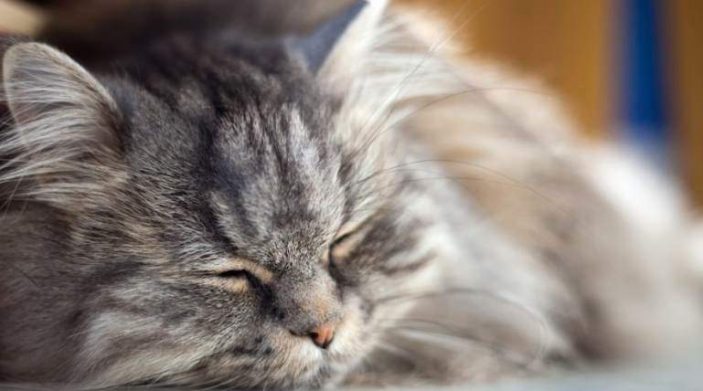Iron (Fe), a heavy metal, is one of the trace minerals required by cats and dogs. Whereas iron has many essential functions including in the formation of hemoglobin, excessive amounts can lead to toxicity.
This toxicity, which is lethal, occurs when a cat’s iron blood level goes higher than required. This can possibly result in cell damage (as this mineral is absorbed into cells) and other detrimental effects including liver damage and GI mucosa irritation.
Various forms of iron including ferrous fumarate, sulfate, gluconate, lactate or carbonate, ferric chloride, pyrophosphate, hydroxide or ammonium citrate as well as ferrocholinate, Ferro glycine sulfate and peptonized iron among others can cause toxicity.
Once absorbed, iron mineral gets bound to transferrin produced by the liver for transportation to the bone marrow, liver and other places where it is needed. Some are stored by ferritin (an intracellular protein that stores it in cells) where it can be released whenever it is required.

Should the amount available in blood plasma overwhelm transferrin ability to bind with it, there will be a saturation of transferrin in blood as well as free iron in blood serum.
Normally, cat’s bodies cannot excrete the excess amount including the free one. Instead, hormone hepcidin helps regulate the amount taken by the body, therefore it causes toxicity.
Furthermore, free iron is not only a strong oxidant, but it is also quite corrosive. It can damage epithelial cells, cause mucosal ulceration and necrosis.
Finally, the excess amount will also be deposited in the liver leading to liver mitochondria damage and consequently hepatic necrosis.
Causes
Ingesting compounds that contain iron that is in a more bioavailable form and “overdose via injection of agents to treat iron deficiency” as Today’s Veterinary Nurse notes are the most common cause of the poisoning. This includes supplements for managing iron-deficiency anemia.
It is unlikely that normal diets will be a cause unless they lead to accumulation of this mineral.
Some of the products that have iron commonly found in homesteads include birth control pills, prenatal vitamins, iron pills, pregnancy supplements, fertilizers, snail and slug baits, iron-rich human pills, feet and hand warmers, wrappers that absorb oxygen among others.
Also, giving your cats wrong multivitamins or iron supplements for cats without figuring in your cat’s age, health status or amount may result in an overdose.
Toxicity arises since cats are unable to remove excess amounts Fe from their body (do not have a way to excrete excess amounts.
When does toxicity occur?
Usually, it occurs when cats ingest over 20mg of elemental iron per kg of body weight and when the amount is between 20-60mg, mild symptoms may be noted. However, if the amount is above 60mg, symptoms are detrimental while amounts over 100mg/kg will cause death if there is no urgent treatment.[2]
The poisoning often affects liver, nervous, metabolic GI and cardiovascular systems and it should not be ignored as it can be fatal.
Symptoms
Symptoms to expect will depend on the amount of iron ingested and the duration since it was ingested. These signs include:
- Vomiting and diarrhea (with or without blood), abdominal pain and depression may be noted within six hours
- Apparent recovery will then be noted after 6-24 hours
- After 12-96 hours symptoms such as vomiting, diarrhea, GI hemorrhage, depression, lethargy, hypovolemic shock, tremors, increased heart rate, low blood pressure, painting, cardiovascular collapse or acidosis may be observed.
- Finally, there may be a formation of a stricture leading to the GI being obstructed in case of prolonged durations of 2 to 6 weeks.
Mild cases of toxicity may resolve on their own after 6-24 hours while if your pet ingested a lot of this mineral, symptoms may persist for several weeks.
Diagnosis
After inquiring on your cat’s health history, when you noted the symptoms, why you suspect iron poisoning, your vet may consider urinalysis, blood biochemistry profile, complete blood count, among other tests to check if there is a high level of Fe ions in blood plasma.
Also, X-rays may help reveal any deposits of this mineral in the liver or in the gastrointestinal tract.
Finally, an iron panel may help detect ferritin concentration, the concentration of transferrin percentage and iron binding capacity.
Treatment
Your vet may consider hospitalization, IV fluids to correct resultant shock, induced vomiting to get rid of any iron that has not been absorbed and use of a saline solution to wash off stomach content (gastric lavage) if there is not GI hemorrhage.
Also, your vet can consider GI protectants to minimize irritation and damage such as milk of magnesia to act on iron. Also, there may be chelation with deferoxamine (if levels are dangerous), among other treatments.
The use of activated carbon may not help since it does not bind well with iron.
Afterward, there liver and blood enzymes should be monitored, follow-up tests are done and looking out for any chances of GI obstructions for the next six weeks.
Also, a for permanent liver damage may be necessary if the amount ingested was so high. Liver damage might require long-life care.
Homecare and prevention
There are no home-based treatments for iron toxicity in cats and you need to immediately inform your vet should you notice any of the symptoms we have mentioned or suspect that your feline friend has ingested products rich in this mineral.
Secondly, ensure you keep any products that contain iron in places where your feline friend cannot access. This should be the same case for vitamin A, D, and 5-HTP.
Finally, avoid any iron supplements for cats unless advised so by your veterinarian.

(last line probably means veterinarian)